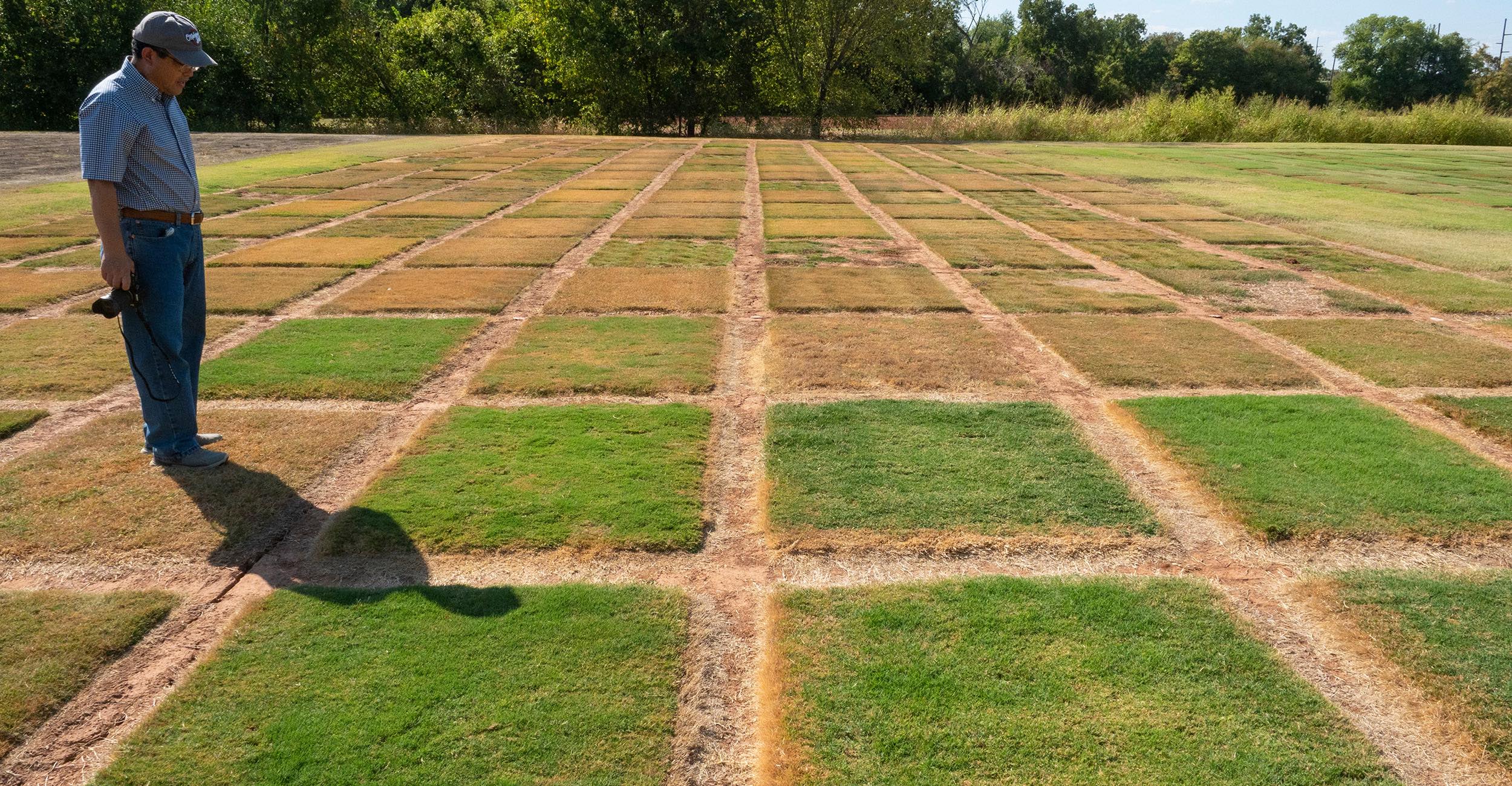
How the green grass grows
Thursday, May 19, 2022
Media Contact: Alisa Boswell-Gore | Agricultural Communications Services | 405-744-7115 | alisa.gore@okstate.edu
Explaining the process behind creating OSU's world-renowned turfgrass
Oklahoma may be known for its tallgrass prairies immortalized in classic Westerns, but for Oklahoma State University researchers, it’s the short grass they want remembered.
Turfgrass, that is. Specifically, Bermudagrass, known for its cold hardiness and drought resistance. OSU’s most recently released variety, Tahoma 31, has become a staple on not only lawns but also major sports venues around the world, from Dodger Stadium and Churchill Downs to the Philadelphia Eagles football stadium.
OKC1876 and OKC3920 — the two latest Bermudagrass varieties developed at OSU — are great examples of the extensive testing and the experience needed to develop quality turfgrass.
When the Bermudagrass growing season, usually April-October, comes to a close, OSU scientists turn to lab and greenhouse testing over the winter months to make the best use of time in testing new experimental varieties.
This research process has taken place almost every year at OSU since the mid-1900s. Traditionally the entire process for the release of a new variety of turfgrass has been 10 to 15 years and requires an extensive greenhouse, lab and field screening and a testing process that can include more than 1,000 experimental plants.
This lengthy stretch of time between the start of studying an experimental line and it going to commercial market is because there are many steps and processes that must happen to ensure OSU is releasing the highest quality of turfgrass varieties.
Genetic attributes in Bermudagrass are studied at the same time experimental lines are being created, which helps in the selection process of current and future lines. Features are studied and lines are tested to determine what causes desired attributes in turfgrass, such as cold hardiness and drought resistance. Then breeding turfgrasses to obtain those genetic traits begins.
Scientists must then study these bred varieties over the course of several years to determine if they have the quality and traits to make them viable for the commercial market. From there, licensing with producers and private industry occurs. At this stage, it can take 2 to 4 years for the turfgrass to be widely available in the commercial market for purchase.
“A variety can fail at any point in the chain and a variety can even fail once it has been released to the market,” said Dr. Yanqi Wu, OSU plant and soil sciences professor and plant breeder. “Breeding and development is a very high risk venture and success is not guaranteed even with significant expenditure of time and funds. Even with its breakthrough status and all the research and planning behind it, there can still be problems ahead for OKC3920 as new disease and insect problems, environmental stresses and changes in the industry are a constant Even if success in the market is achieved, the duration of that success is not guaranteed.”
Wu said with his team working on thousands of experimental lines each year, new turf Bermudagrass varieties are usually released once every several years.
The research involving the two most recent varieties being released involved around 9,000 experimental plants.
"After initial evaluation, the breeder will select around 20 to 30 plants to be sent to collaborators across the U.S. to evaluate sod tensile strength, freeze tolerance, drought resistance, traffic tolerance, shade tolerance, disease resistance, golf ball roll distance and so on,” Wu said. “Every five years, the development team will submit two to 10 of their best selections to the National Turfgrass Evaluation Program where around 10 to 20 university scientists around the country will evaluate turfgrass performance and adaptation.”
The information gained from national testing is used to decide whether or not to release the experimental varieties to the public, and if so, to secure proprietary protection in the form of U.S. Plant Patents or Plant Variety Protection Certificates.
With a lot of hard work, a great deal of testing and some setbacks, scientists find the variety with the right genetic makeup to have strong color, durability, drought resistance, cold hardiness and more.
In the meantime, OSU scientists continuously pursue their molecular research on the two parent species, African Bermudagrass and common Bermudagrass, using DNA markers to study the genetic inheritance of important traits.
“We have developed most of the molecular marker tools in the world for Bermudagrass,” Wu said.
With these tools, scientists map the genomes of different Bermudagrass varieties, and improved varieties of turfgrass are created.
“We have already developed more than 3,000 genetic markers, but there is more work to do,” Wu said. “It is all about little steps moving forward then combining all of those little steps to make larger progress.”
Wu said the research is a collaboration among OSU scientists, graduate students and technicians, as well as scientists from other universities. Funding is provided by the U.S. Department of Agriculture, the U.S. Golf Association and the Oklahoma Center for the Advancement of Science and Technology.
“We want to always work toward better water conservation and water-use efficiency regarding grasses and sustainability traits,” Wu said.
Wu predicts the industry could probably save millions of dollars if more facilities used cold-hardy and water-use efficient grasses.
“I think our work has really produced some national impact. OSU grasses have been used in many places, and we are proud of that,” Wu said.
The turfgrass industry contributes over $40 billion per year to the U.S. economy and over $1 billion per year to the Oklahoma economy. According to the 2016 U.S. Golf Economy Report, $84.1 billion in activity was directly driven by golf in 2016, a 22% rise from $68.8 billion in the 2011 report. The industry supported $191.9 billion in total annual activity that year, including 1.89 million jobs and $58.7 billion in wages and benefits.
OSU Ag Research is Oklahoma's premier research and technology development agency in agriculture, natural resources and the life sciences.
